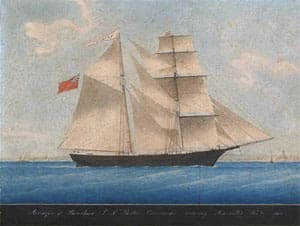Any discussions concerning the mysteries of the sea and sailing ships will usually include, at least amongst knowledgeable mariners, passing mention of the disappearance of Mary Celeste. The story of this ship and her crew has teased folks for more than 100 years, and even after all that time, there is still nothing but conjecture and theories concerning the fate of her crew.
Some background: Mary Celeste was a Nova Scotia-built brigantine (square sails on the foremast, fore and aft sails on the main mast), built in 1860 for the cargo trade, carvel-planked, and launched as Amazon. The vessel was 93 feet LOA, with a 25-foot beam, drawing over 11 feet. Like many other ships built of this period, Amazon was built to haul cargo, working primarily in England, the Mediterranean and the West Indies. In 1867, she was run ashore for insurance and abandoned at Cape Breton Island. The hull was bought as a wreck, with U.S. owners, and was registered as Mary Celeste in 1872. The vessel underwent a considerable refit where it was lengthened to 103 feet and a new second deck was added. It was at this time that Captain Benjamin Spooner Briggs, part-owner, was given command. Captain Briggs hailed from a seafaring family, was a devout Christian, married his cousin and had two kids. On the first voyage, after an extensive refit, Briggs along with his wife and 2-year-old daughter, departed in October of 1872 for Genoa. The crew and officers were all well-vetted, able and sober seamen.
In New York, they loaded 1,701 barrels of denatured alcohol, clearing the harbor on Nov. 7. On Dec. 4, 1872, at a position of 38° 02’ north, by 17° 15’ west, about 400 miles east of the Azores, the ship Dei Gratia spotted Mary Celeste sailing erratically. The crew boarded the ship and found it deserted with the single lifeboat missing. The last log entry was for 0800 on Nov. 25. Mary Celeste was then at DR 37° 01’ north by 25° 01’ west. There was plenty of food aboard and no signs of fire or violence.
The chronometer, the sextant and ship’s register were missing. The wheel was not lashed and the ship was under shortened canvas. Foresail and fore upper topsail were blown away. There was six months’ provision aboard but no meal on the cabin table as was once reported, or any cooked food in the galley. The log was found but revealed nothing. The vessel was described by one of the seamen who boarded her as “fit to go around the world.”
Mary Celeste was insured for $14,000 and appraised at $16,000. Her cargo was valued at $37,000, and the freight payable delivered to Genoa was $3,400. These are not large sums, so the idea of insurance fraud for the disappearance of captain and crew makes no sense. Also, it should be noted that the sailors’ smoking pipes were found — even a conniving mariner would never leave his pipe behind.
The captain of Dei Gratia laid claim to Mary Celeste and brought it to Gibraltar for salvage. There was an extended admiralty hearing where initially it was believed that either the crew of Dei Gratia murdered the crew of Mary Celeste, or that the captain of Mary Celeste and the captain of Dei Gratia were in cahoots acting to create an insurance fraud.
After those ideas were eliminated, it was thought that the skipper and his officers and family may have been murdered by drunken crew. There were all sorts of theories as to what happened on Mary Celeste running the gamut from pirates to religious hysteria to displaced iceberg to waterspout to a misreading of the amount of water in the bilges to toxic fumes rising from the denatured alcohol.
When Mary Celeste finally departed Gibraltar, the vessel went back into the West Indian trade. In 1884 off Haiti, the ship was deliberately run aground for insurance. The captain and officers were found out and none met the end they had anticipated.
What we know is that crime, piracy, or fraud had nothing to do with the mystery. The most agreed-upon consensus is that alcohol fumes escaped from the hold when the fore hatch was opened. The crew panicked, got in the long boat, thinking an explosion was imminent, and was somehow separated from Mary Celeste and were lost in the life boat.
The mystery was enhanced when Arthur Conan Doyle wrote a story about the ship, in 1884. In 1934 Bela Lugosi played a psychotic sailor in a film titled “The Mystery of the Marie Celeste,” and as recently as 2007 the Smithsonian Channel aired a documentary on the disappearance of the crew. To date though there is still no consensus as to what might have befallen Captain Briggs, his wife, child and the seven crew.
Let’s join Captain Briggs on his approach to the Azores while everything was still under control. It is Nov. 20 (use the 2015 Nautical Almanac), and the ship is at a DR of 36° 23’ N by 27° 15’ W. Captain Briggs is preparing for a noon sight of the sun. His height of eye is 15 feet. He is taking a lower limb observation and the Hs of his sight is 33° 46 08’ There is a 2’ index error on the arc.
A. Calculate the time of LAN at the DR.
B. Reduce Hs to Ho
C. Find latitude at noon
Plot LOP
Answers:
A. Lan at DR is13:35 GMT
B. Ho 33° 55.8’
C. Latitude is 36° 22.9’ N

